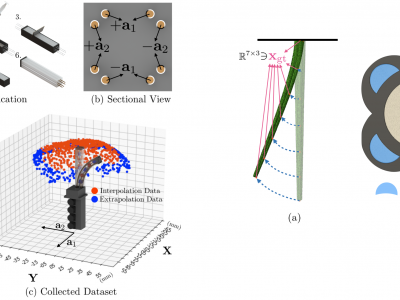Machine Learning
Soft robots are a promising area of research due to their potential use in various applications. Learning the kinematics of soft robots is crucial for their advancement and application. This dataset is designed to provide training data for the development of machine learning models that can learn the kinematics of soft robots with different actuation types. The dataset includes the positional data of three soft robots, specifically the simulated pneumatic soft robot, simulated tendon-driven soft robot, and real-world tendon-driven soft robot.
- Categories:
 80 Views
80 Views
(a) The sample stage lifts the sample up to the tip of the cantilever until the tip-sample distance is about 2 mm or less, which facilitates safe pre-approach between the tip and the sample. (b) The laser-cantilever is aligned by moving the laser, while detecting the tip and the sample and measuring their positions. (c) The laser beam reflected from the cantilever head is aligned with the center of PSPD based on the electrical signals of PSPD.
- Categories:
 55 Views
55 Views
Normal
0
7.8 磅
0
2
false
false
false
EN-US
ZH-CN
X-NONE
- Categories:
 54 Views
54 ViewsThe advancements in the field of telecommunications have resulted in an increasing demand for robust, high-speed, and secure connections between User Equipment (UE) instances and the Data Network (DN). The implementation of the newly defined 3rd Generation Partnership Project 3GPP (3GPP) network architecture in the 5G Core (5GC) represents a significant leap towards fulfilling these demands. This architecture promises faster connectivity, low latency, higher data transfer rates, and improved network reliability.
- Categories:
 3935 Views
3935 Views
The Inverter Fault Diagnosis dataset is a comprehensive collection of data aimed at facilitating research and development in the field of fault diagnosis for solar integrated grid-side three-phase inverters. This dataset includes three key features, namely Ea, Eb, and Ec, representing the energy calculated from the fault currents for phases A, B, and C, respectively.
- Categories:
 1333 Views
1333 Views
There is a growing trend towards combining mathematics and computer science education. Although there are surely synergies between the two disciplines, has sufficient thought been given to the benefit of fostering independently the unique skillsets they offer in order to best harness these synergies?
- Categories:
 74 Views
74 ViewsCattle health monitoring is essential in the modern world, because of the high demand for dairy products. Regular monitoring is essential to extend the lifecycle of cattle and maintain the quality of dairy products. Unfortunately, Observing the health of cattle regularly is difficult in large farms where workers do not have enough time to do so. This paper described IoT devices such as skin temperature, heart rate, and motion sensor. Using this device, you can monitor cattle’s heart rate, activity level, heat stress, the surrounding temperature, and sleep tracking.
- Categories:
 3339 Views
3339 Views
The dataset contains the processed snap shots from several news channels with commercial L bands and I bands that comes during the broadcasting of news and this dataset particularly focuses on the TV commercials and advertisements in L shped form. This dataset is useful for further analysis on this domain, detecting the L shaped band from news channels and further analysis on that which will be useful for news channels any other bradcastinh channels such as sports and also it will be helpful for the advertising agencies and companies.
- Categories:
 574 Views
574 Views
In this investigation, the researchers have used a commercially available millimeter-wave (MMW) radar to collect data and assess the performance of deep learning algorithms in distinguishing different objects. The research looks at how varied ambiance factors, such as height, distance, and lighting, affect object recognition ability in both static and dynamic stages of the radar.
- Categories:
 710 Views
710 ViewsThree exemplary knee bone models derived from ultrasound imaging and their respective magnetic resonance imaging reference.
Apart from the ground truth, a partial scan as accessable by ultrasound imaging as well as full bone model computed by a statistical shape model is provided.
- Categories:
 544 Views
544 Views


